The oscar fish goes by many names - Oscar Cichlid and Velvet Cichlid being two. Originally hailing from the Amazon basin of South America, this tropical freshwater fish is incredibly popular.
Oscar fish are very intelligent fish, and they are also playful and beautiful. Oscar fish has earned the nickname "water dogs." That's right, they will waggle their heads and fins when they recognize you walking into the room like a dog! However, they are also high maintenance and can become aggressive. You'll need to know exactly how to care for one if you'd like to bring an oscar fish home as a pet!
What Are The Tank Requirements?
Tank Size
Oscar fish grows incredibly fast, and it's best to be set up for their adult size from the beginning. They will grow at a rate of 1 inch per month until they reach adulthood, capping out an average length of 10 to 12 inches. You will need a minimum tank size of 55 gallons per fish, or you risk disease or premature death. Since oscar fish enjoy living in pairs or small groups, it's recommended to have more than one and adjust your tank size accordingly. Keep in mind that oscar fish have long lifespans. It would be best if you planned to have your aquarium available for a good 20 years.
Tank Maintenance
Oscars are messier than most other fish, producing a lot of waste. You'll need to change their water frequently. The smaller the tank, the more frequently you'll need to clean it out and change the water. They are sensitive to changes in their water parameters and are susceptible to all of the common tropical fish diseases, which we will discuss further on.
Water Parameters
Oscar fish is particularly sensitive to water parameters. The perfect water temperature is between 75 and 80 degrees Fahrenheit. A pH balance between 6 and 8 is preferred, and while they are more tolerant of variations in water hardness levels, it's best to keep it between 12dH and 15 dH.
Because changes in temperature and ammonia levels can cause such troubles with Oscars, it's important to invest in a quality water filtration system and an aquarium heater that has a thermometer built-in.
Plants
One of the joys of owning oscar fish is how much personality they have. This shows their tendency to rearrange their tank, moving plants and rocks to and fro as it pleases them. However, they are also often unpredictable and moody. They might love plants one day and uproot and throw them about the next. Provide plants that are hardy and can survive these whims of interior decorating. Or, consider using floating plants to add some green to your aquarium without giving your fish too much opportunity for tantrums. Make sure that you choose plants that need the same water requirements as your oscar. Some favorites are Java Fern, Salvinia Natans, and Java Moss.
Accessories
Decorating an oscar tank can be challenging, as they are large fish and will rearrange their tank. You can place a large rock or driftwood as a tank centerpiece.
Oscar Fish Food
Oscar fish are particular about their tank but not as much about their diet. They're big fish, and they're hungry. In their natural habitat, oscar fish eat small insects and crustaceans. While you can offer feeder fish such as Goldfish or Rosy Red Minnows, they aren't the best nutritional fit and usually have too much fat.
It's recommended to feed oscar fish an equal amount of processed flake or pellet foods and live foods like insects or shrimp. A balanced diet will help make the colors of your fish more vibrant.
Processed and Pellet Foods
Some fish food companies produce pellet food specifically for cichlids. These serve as great base pellet food. Oscars will also require supplemental vitamin C and plant matter, which they would otherwise accumulate naturally in the wild. Algae supplements are a great way to boost plant matter in the diet without creating bloating problems.
Live Foods
While you can occasionally offer feeder fish, it would better mimic the natural diet of oscar fish. This includes brine shrimp, krill, and bloodworm to their diet.
What Are Suitable Oscar Fish Tank Mates?
Depending on how much space you have, we really recommend having an oscar ONLY tank. Oscar fish do best in pairs and are in small groups, but they are large fish and require large amounts of water. Oscar fish are territorial fish, making it harder to find suitable tank mates. While it may be tempting to add some small fish to this huge tank that only has oscars in it, the tank will be overcrowded long before it looks overcrowded. If a fish is small enough to be eaten, it will be.
If you must add other fish, it's important to find the right tank mates. The best options are large and non-aggressive, such as Large Plecos, Arowanas, Convict Cichlids, Firemouth Cichlids, and Jack Dempseys.
Can I Breed Oscar Fish?
Breeding oscar fish is tricky. They are one of the more difficult freshwater fish species to breed successfully. They are very picky at choosing a mate and won't reach maturity for spawning until two years of age. Many fish owners opt to purchase a mating pair that already has a record of producing offspring.
Female Oscars will cycle into breeding in the wild when they sense that they are in a rainy season. In a home aquarium with regular water parameters, that's harder to simulate. To create your own "rainy season" for breeding purposes, change out about 30% of the tank's water every couple of days, drop the temperature a few degrees, and simulate rainfall multiple times of day by either a watering can or a spray bar. Some fish owners choose to have a separate breeding tank for all of these reasons.
What Are Common Oscar Diseases?
Even the healthier Oscars will get sick at some point during their long lives. Sticking to a balanced diet and the preferred water parameters will go a long way in keeping these diseases at bay.
Hole In The Head
The hole-in-the-head disease gets its name from the growth of cavities and holes across the fish's head and body. While it sounds gruesome, it's not particularly hard to treat. Nutritional deficiencies usually cause it, and it's time to reassess the diet.
Tropical Fish Diseases
There are a wide variety of diseases common to tropical fish, such as ich, dropsy, fin rot, and tail rot. For oscar fish kept in aquariums, these diseases are almost always introduced through live feeder fish. Before adding them to your main tank, make sure you quarantine any fish, whether they be tank mates or future food.
Types of Oscar Fish
Tiger Oscar Fish
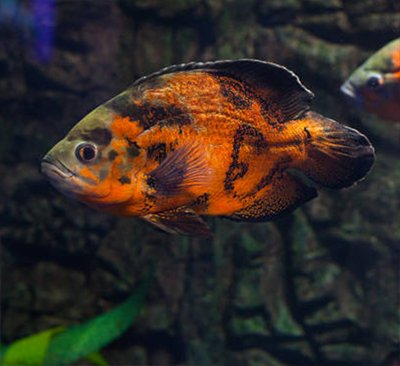
Tiger oscars are the most common color variation, and they are a variety of orange and black. The base color will be either black, charcoal, or dark brown, and the stripes vary from orange to red. This variety can reach 8-16 inches long.
Red Oscar Fish
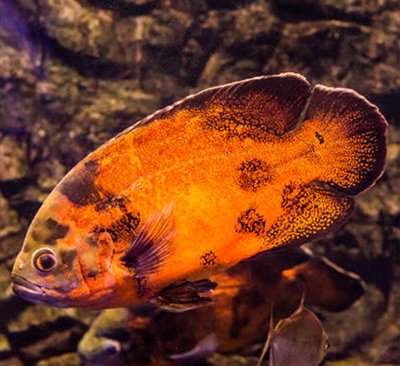
This variety has an orange or red body and fins, but the head will be black or gray. Red oscar fish usually reach 11-12 inches long.
Albino Oscar Fish
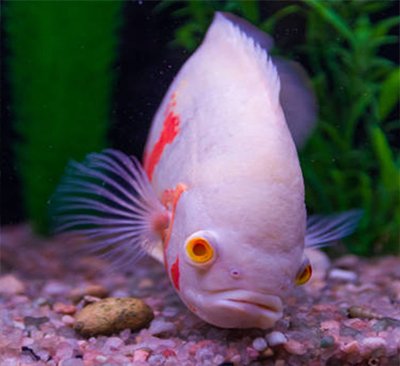
Albino oscars will have a solid white or slightly pink body with deep orange bands, and their eyes will be yellow, pink, or a pale red. This variety can reach 10-14 inches long.
Black Oscar Fish
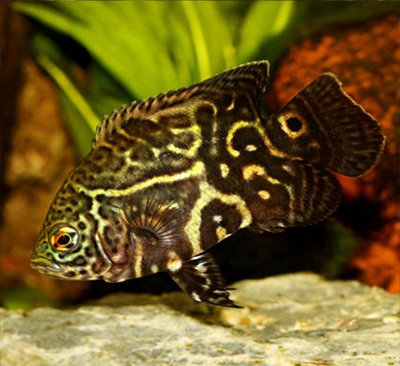
While most color varieties of oscar fish were the results of specific breeding, the black oscar fish shows up in the wild. They look similar to the tiger oscar fish, but there are significantly more black scales than orange. This variety can reach between 10-12 inches long.
Green Oscar Fish
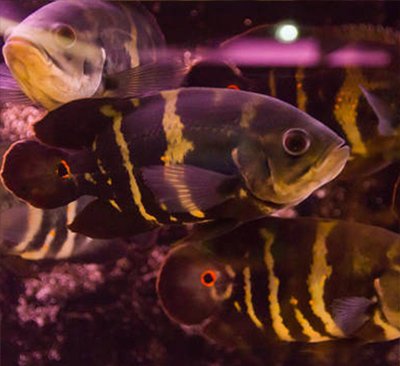
This variety of oscar fish is one of the most extravagant types of all. The green color can show up either as the base color or as dark green bands color. They also have an amazing variety of patterns and coloration. This variety can reach up to 12 inches long.
Lemon Oscar Fish
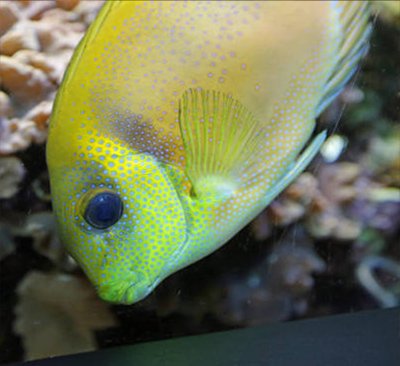
This stunning color variety of oscar fish is extremely popular. The vibrant yellow body is super eye-catching and can reach up to 12 inches long!
